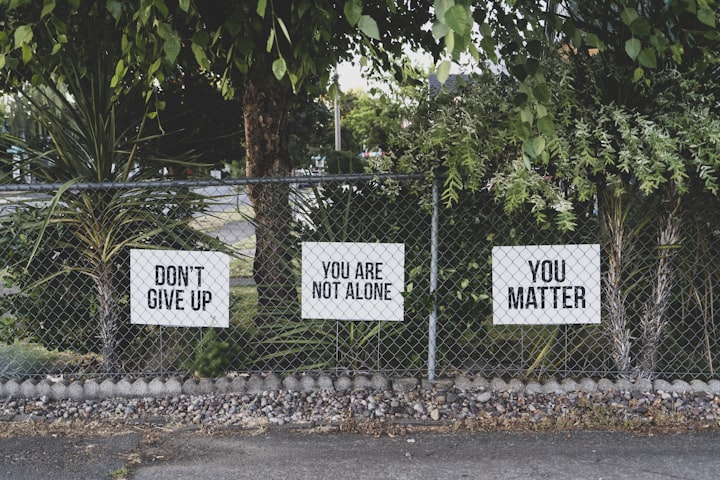Self Harm & Suicide
You're Not Alone - We are Listening To You

Self-harm & Suicide is a very evocative subject to both discuss with others and to write about. But nevertheless, it is a topic that MUST be talked about freely and widely at the same time too - with everyone. Self-harm & Suicide if not talked about, and the person feeling suicidal not feeling that he/she is being heard, can all too easily escalate to attempting suicide themselves. Within 2019 alone, it was recorded that a terrifying total of 5,691 suicides were registered in just England and Wales (source, Office for National Statistics (ONS.)) Which is staggering and very disappointing - as it shows many people are 'falling through the loop,' at NOT being heard.
At this time, the records for 2020-2021 are still being revised for publication by the ONS.

Before carrying on any further with this article, PLEASE, talk to the person next to you and they will listen and point you forward to speak with your registered doctor - who can listen actively and refer you to the local area Community Mental Health Team (CMHT.) If you live alone PLEASE pick up your telephone and chat with a relative or friend. If it is easier for you, talk over social media to your friend(s.)
I have included contacts within the UK area that can provide support for you:
-- Samaritans – call 116 123
-- Campaign Against Living Miserably (CALM) call 0800 58 58 58 (5pm to midnight)
-- Papyrus (or people under 35) call 0800 068 41 41 (9am to midnight)
-- Childline (for children and young people under 19) call 0800 1111
-- SOS (Silence of Suicide) call 0300 1020 505 (4pm to midnight every day)
-- GP is always available to call 111 if outside of surgery hours
-- as always call 999 if it is very urgent
I have included these contact points from knowledge gained during my 'Self-Harm & Suicide Awareness' training during Mental Health Nursing - which is up-to-date within the UK at the time of this article being written.
I have included the link below to two of my articles that relate to this, which I hope you will take the time to read:
https://vocal.media/psyche/time-to-let-go-sd6hyv0wux
The next one is about how mindfulness can help & some of the things you can do, as using mindfulness techniques can enable you in distracting your current mind and assist you into thinking of other areas:
https://vocal.media/psyche/garden-therapy
Is there Hope of Better Things
Yes, there is, is the simplest answer to that. Whereas there is much difficulty in being able to get the message across, that you 'are in pain' emotionally, the use and skills attributed to non-verbal communication and active listening skills are the keys to helping you move forward & grow positively, in a new & positive approach to life.
DBT and CBT
DBT can be offered by your Community Mental Health Team (CMHT) which in short, includes a Behaviour Chain Analysis (BCA) program of events. In the most basic form, it looks toward being able to describe what happened before (how were you feeling), what occurred during (how did the incident make you feel), and after the self-harm event (how did you feel when you stopped.) Mindfulness tools are included within DBT - my link to 'Garden Therapy' above.
CBT can support people in developing different strategies in the ways of thinking and behaving which aims to reduce their psychological distress. It provides more of a 'talking therapy,' whereas DBT involves more physical role-play, group interaction, and (yes just like school) has homework to do.
Self Harm
Those people that do practice self-harm - which includes superficial cutting (which can lead to unintentional death) due to cutting an artery, scratching hard to make marks on your body with redness and soreness, banging your head, taking more tablets than you are actually prescribed, excessively drinking alcohol - doing these because they act (to them) much like a pressure relief valve; the sensation experienced helps them to relieve the emotional pressures, that are clouding every part of their feelings, judgments & actions - that is building up over time. The action(s) is like a 'cry for help,' but sadly can go very, very, wrong. A 'cry for help,' is just as it says - a vulnerable person who is experiencing emotional pain who either feels like she/he is being ignored or not listened to; or simply cannot find any words within him/herself.
-- This is the entire point of 'active listening' skills being appropriately used by the person listening. People who are depressed & self-harming often display more non-verbal communication as opposed to verbal communication. The key to supporting the person is based upon being able to pick up on those subtle 'non-verbal' conversations. And I use the word 'subtle' as this is the best way to describe what non-verbal is - it is silent and can be a very minor action to pick up on - but is a powerful tool in being able to gain an insight into just how your emotions are making a person feel.
Below is an idea of roughly what non-verbal can be interpreted as:
-- Eye contact. Is the person maintaining eye contact with you, or are they looking down, away, or anywhere that avoids this eye contact being held. What about any makeup, it can display the presence of previous tears or through streaks or smudges (sadness, anger, devoid of feelings, or guilt.)
-- Body language. Is the person sitting in front or to the side of you at all? Are their legs crossed and arms folded (presenting as defiant, angry, sad, not wanting to engage with anyone, or simply shut down within themselves.)
-- Facial expressions. Is the person smiling, grimacing, laughing, lips down looking sad (this indicates their emotional position.)
-- Presentation. How is the person dressed? Are they wearing dirty clothing or is there evidence of body odour (which can be evidence of poor or reduced self-care; just not really caring anymore.)
Suicide
This is a very severe result of self-harm by those vulnerable as mentioned earlier within this text - with no going back. Suicide seems to be the only way out of the negative issues being faced by the individual. It can be intentional or unintentional. The effects upon those left behind can be devastating. The 5-stages of Elizabeth Kubler-Ross from her book 'On Death & Dying' are outlined more within my first link at the beginning of this article - 'Time To Let Go.'
REMEMBER - it is good to talk to each other, so let us keep it going - TOGETHER WE CAN MAKE A DIFFERENCE TO A LIFE.
If you have read this article, please heart it - they are lovely and heartfelt. If you wish to provide a tip please do so, but remember, not obligatory. More of my articles can be found at:
https://vocal.media/authors/jonathan-townend
If you wish to message then please do so at:
About the Creator
Jonathan Townend
I love writing articles & fictional stories. They give me scope to express myself and free my mind. After working as a mental health nurse for 30 years, writing allows an effective emotional release, one which I hope you will join me on.






Comments
There are no comments for this story
Be the first to respond and start the conversation.